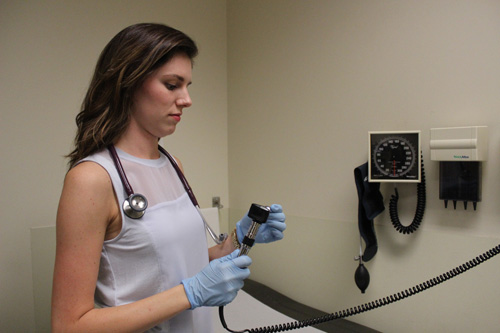
U of T medical student Michelle Gold, pictured in Toronto Western Hospital’s Family Health Clinic, says the new approach to medical rotations “poses a unique opportunity to experience a patient’s journey through the health care system by being present with them at each step.” (Photo: UHN)
For the first time at UHN, University of Toronto medical students will participate in a new patient-centred approach to hospital rotations.
Beginning Sept. 22, third-year medical residents will closely follow a panel of between 50 and 75 patients across medical disciplines simultaneously throughout the year.
The new program – the Longitudinal Integrated Clerkship (LInC) – is an alternative option to most standard medical clerkships across Canada.
Typically, third-year medical students follow a "block-structure," meaning they work in one medical discipline for a few weeks before moving on to the next. Students enrolled in LInC will spend half-days and full-days alternating through various medical departments.
The pilot program
LInC first launched in September 2014 with seven students at St. Michael's Hospital, the designated pilot site of the program.
Jasmine Palohemio, LInC Education Coordinator for UHN and Mount Sinai Hospital, recalls a story from one of the students who completed the program last year.
The medical student was following a pregnant patient who didn't have an extended support network available to her.
"The soon-to-be-mom felt overwhelmed and anxious about her pregnancy," says Jasmine. "The medical student formed a close bond with the patient and supported her through the birth.
"This program is a great example of what this program can do for student and patient relationships."
The patient journey
This fall, three students will participate in the LInC program, part of the Wightman-Berris Academy, and are primarily based at Toronto Western Hospital. UHN is an anchor hospital of the Academy.
These students will also complete their rotations at Mount Sinai Hospital for Obstetrics/Gynecology, Otolaryngology and Sick Kids Hospital for pediatrics. Another four students of Wightman-Berris will be based at the Toronto East General.
"LInC offers a new integrated way for medical students to learn about patient-care that's different from the traditional rotations where they learn subject matter in isolation," explains Dr. Jacqueline James, Director of the Wightman-Berris Academy and UHN/MSH Medical Education.
"It allows students to have a better understanding of the journey that patients and their families really experience, which we haven't been able to offer with the traditional rotations before because they have short-lived touch points with the patients."
Michelle Gold, one of three students starting her LInC rotations this month, explains what inspired her to apply for LInC.
"LInC poses a unique opportunity to experience a patient's journey through the health care system by being present with them at each step," explains Michelle.
"This perspective will help me to understand the impact of my management plans on my future patients, and will allow me to better care for them."
Mentorship and self-directed learning
LInC students are paired with the same doctor in each department, forming a meaningful mentorship model between each student and doctor per discipline.
The students are offered three half-days of free time per week named "White Space." This allows students to schedule appointments with patients they're following.
White Space can alternatively be used by students whose medical interests deviate from the disciplines offered in LInC. In that case, they are connected with a physician in the discipline of interest for mentorship during that time.
"The idea of the White Space is that it really develops the adult learning principles of being a self-directed learner who drives their own education," explains Jasmine.
Incorporating the new into the old
LInC is offered to third-year UofT medical students as an alternative to the traditional block clerkships.
"In education, we recognize that people retain information and learn in different ways," says Dr. James, explaining that some students may prefer one approach over another.
However, Dr. James adds that there are elements of LInC, such as White Space, the patient panel and completing more than one specialty at a time, that the Wightman-Berris Academy would like to see incorporated into the block clerkships within a few years.
"One of the greatest strengths of the LInC program is that it provides students with a holistic view of the healthcare system," says Jasmine.
"Students advocate on behalf of their patients once they have a better understanding of the patient experience. The LInC program fosters a patient-centred lens. It's very rewarding."
For more information, please contact Jasmine Paloheimo, LInC Education Coordinator for UHN and Mount Sinai Hospital by e-mail:
Jasmine.Paloheimo@uhn.ca or visit University of Toronto’s
LInC webpage.
